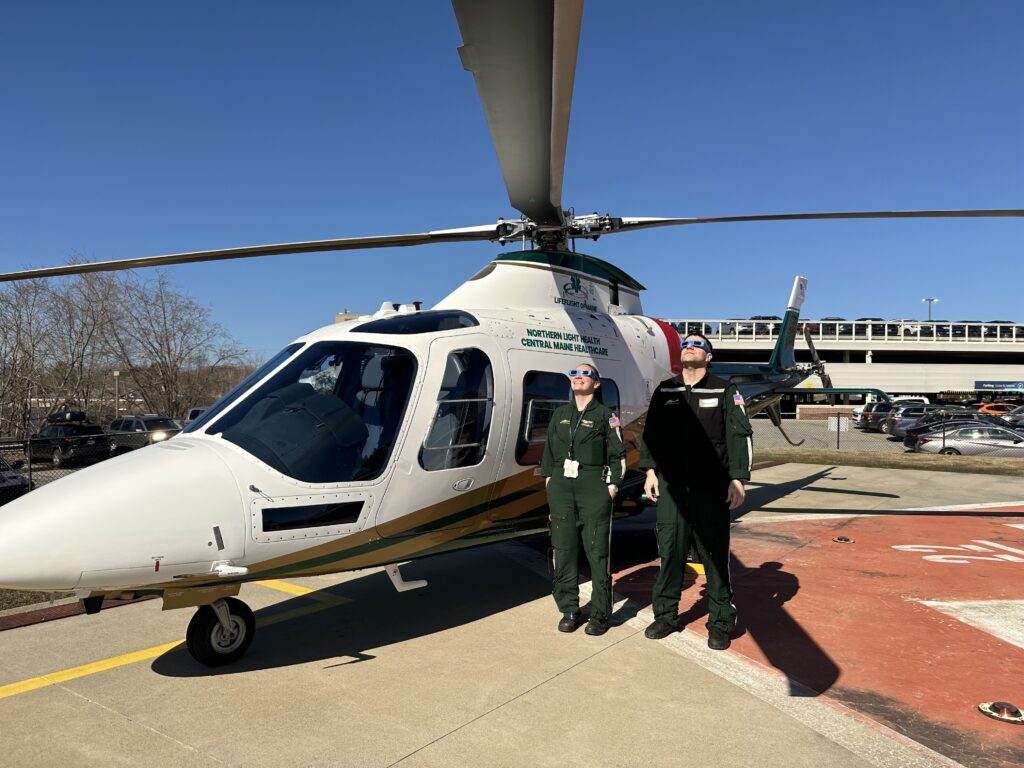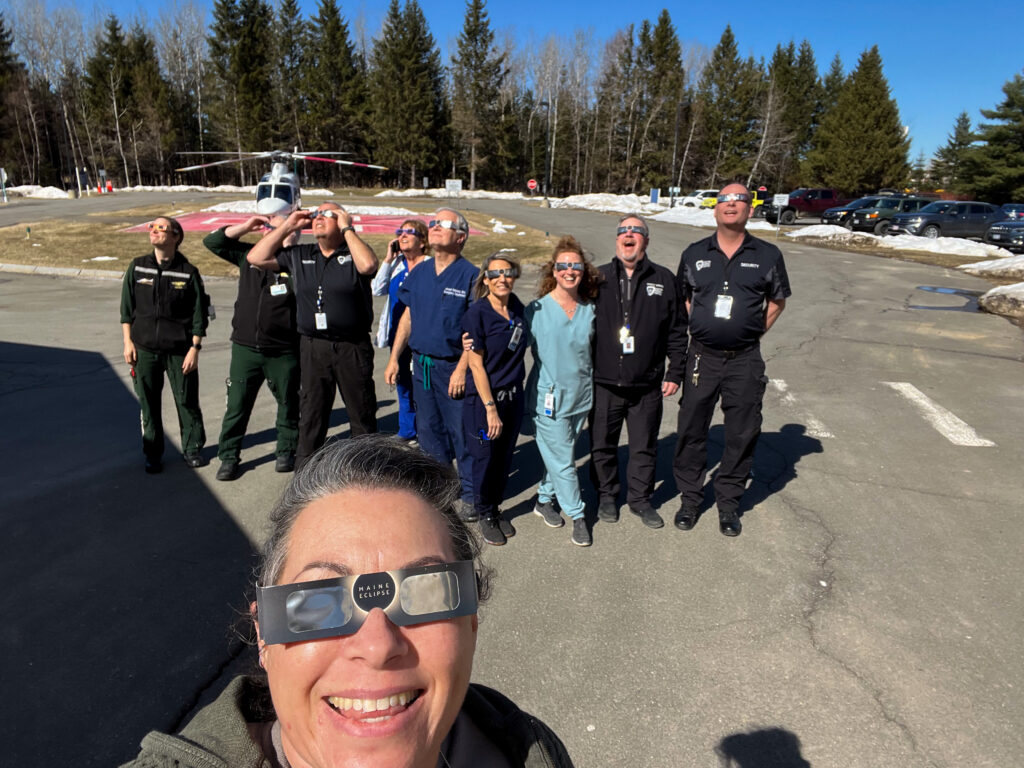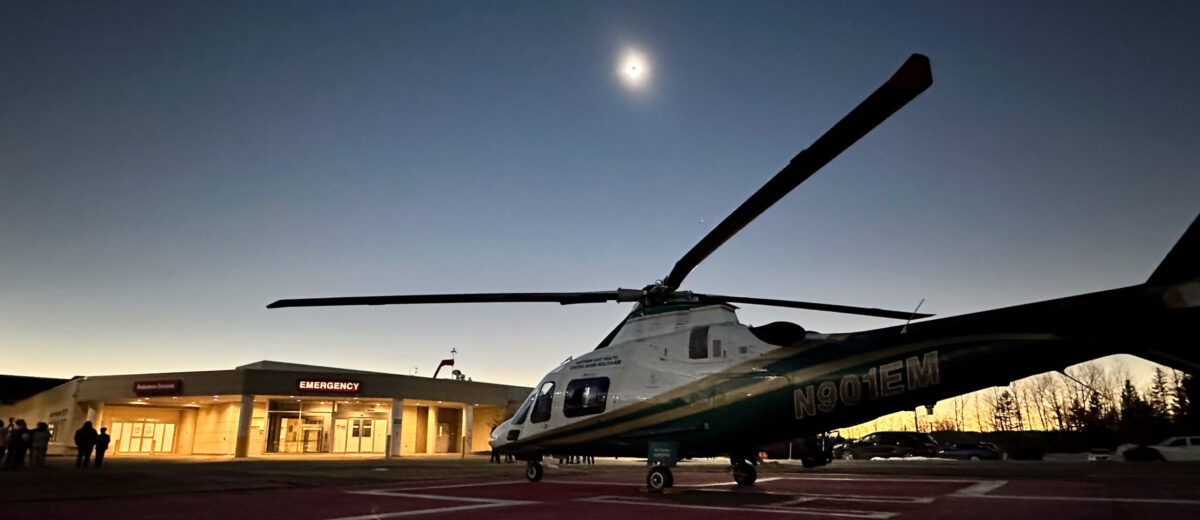Emergency Medicine Along the Path of Totality: How LifeFlight Provides a Critical Safety Net for Explorers of the Maine Outdoors
The Maine Turnpike Authority reported that approximately 30,000 motorists passed through the York toll plaza in a single day: Sunday, April 7, 2024, the day before the solar eclipse. That merely counts cars on Interstate 95 northbound, which is the largest but hardly the only road into Maine.
So many private planes landed at Greenville Municipal Airport that the airport closed one of its runways to park aircraft. Officials in Jackman estimated that about 10,000 people visited the area for the eclipse — Jackman has a population of 783.
The solar eclipse was an event comparable to Labor Day weekend in terms of highway traffic in southern Maine and with few precedents up north. Thousands of Mainers along the coast drove inland and northward to witness a once-in-a-generation celestial occurrence. While clouds covered parts of the path of totality in the Midwest, sunny skies in Maine enticed more last-minute visitors, bringing a welcome economic boon during mud season.
LifeFlight 1, the helicopter crew based in Bangor, beat the traffic to Houlton, strategically repositioning the asset closer to where a potential need might arise. A fourth helicopter crew was also brought online for the day (LifeFlight typically staffs three, in addition to its airplane crew). LifeFlight worked with local first responders and emergency service agencies for months to prepare for any number of scenarios that could potentially have played out. Better to be prepared and not needed, than the alternative.

A solar eclipse is a rarity. Labor Day weekend traffic happens annually, as does the inflow of visitors to Maine throughout the year. The Maine Office of Tourism estimates that 15.3 million people visited Maine in 2023 — that’s nearly twelve times the state’s population. This is a multi-billion-dollar economic force. But with all those people visiting, especially for recreation in the more rural parts of Maine, medical emergencies are statistically assured. LifeFlight is an integral part of the system built to respond, and thus a critical partner to the tourism industry.
LifeFlight is a lifeline for people across Maine, but particularly for communities up north and down east. In 2023, LifeFlight transported 889 patients to Northern Light Eastern Maine Medical Center (EMMC) in Bangor, which is the nearest trauma center for the northern half of the state, as well as much of the midcoast and western mountains. LifeFlight is typically called to Rangeley, Bethel, and Carrabassett Valley several times each during the ski season. Patients come from snowmobile trails, summer camps, island getaways, coastal vacation destinations, and community hospitals. They are facing traumatic injuries sustained during adventures, but also other medical events like cardiac arrests and strokes.
LifeFlight creates access to lifesaving care, especially in rural areas. It works closely with its hospital and EMS partners, local first responders, ski patrols, park rangers, the Maine Warden Service, and other agencies to get patients the level of care they need as quickly as possible. It supplements medical resources in smaller communities by bringing ICU-level equipment and clinicians to town with the speed of aircraft, turning helicopter landing zones and runways into healthcare access points.

LifeFlight’s clinicians are trained, experienced, and authorized to provide certain interventions that medical professionals in smaller hospitals may not have the experience for simply because circumstances rarely necessitate it. For example, intubating infants and small children is a challenging task performed in high-pressure situations. Thankfully, it is also relatively rare in community hospitals. LifeFlight’s nurses and paramedics transport hundreds of pediatric patients annually, many of whom require advanced interventions and resuscitation. Clinicians at a sending facility often defer to the LifeFlight crew to perform these procedures before transferring the patient into a LifeFlight asset.
Medical emergencies do not discriminate between Mainers and those from away. Tourism is a tremendous economic driver in Maine, and the state’s emergency medical system is called upon to care both for residents and visitors. For many of the most critically ill or injured people in Maine, LifeFlight is their last best chance.
On April 8, 2024, the system worked. Emergency medical resources, including LifeFlight of Maine, were available when called upon. Maine’s EMS system was there for the people of Maine and all those who traveled to some of the most ruggedly beautiful parts of the state to experience an awe-inspiring three minutes and 18 seconds of darkness. The path of totality may not cut through Maine again in this era, but tourism shows no signs of slowing, and LifeFlight of Maine will continue to stand ready for every single person, whether they are here for a day, a week, or a lifetime.

